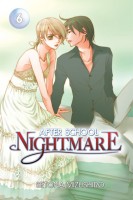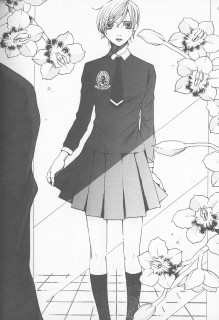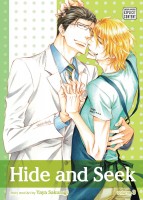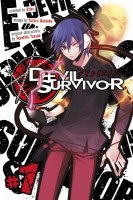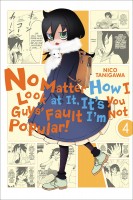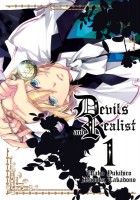My News and Reviews
It was a two-review week at Experiments in Manga last week. First off, I reviewed the third and final volume of Hide and Seek by Yaya Sakuragi, which I enjoyed immensely. In general, I tend to like Sakuragi’s boys’ love manga, but I think that Hide and Seek has probably become my favorite. It’s a bit more serious and realistic than some of her other manga, but it still has a great sense of humor. The second review from last week, and the most recent addition to my ongoing monthly horror manga review project, was After School Nightmare, Volume 6 by Setona Mizushiro. The series continues to be both disconcerting and compelling; I’m looking forward to seeing how it continues to develop.
Elsewhere online: The Shojo Beat tumblr posted a short interview with Kyousuke Motomi. Tofugu presents Japanese Onomatopoeia: The Definitive Guide, which is pretty great. The BBC has a brief spot on Hajime Isayama. Coming out of the New York Comic Con, Women Write About Comics had a chat with Kodansha executives Hiroaki Morita, Kohei Furukawa, and Yasumasa Shimizu. Brigid Alverson reports on Kodansha’s panels at New York Comic-Con, which included Yohei Takami, the editor of Noragami, as a special guest. Masashi Kishimoto was in New York for NYCC as well. Deb Aoki covered Masashi Kishimoto’s NYCC visit for Anime News Network. Brigid Alverson reports on Kishimoto’s main panel. Weekly Shonen Jump Blog has some Kishimoto NYCC videos to share, including interviews and panels. Also, the recording from Kishimoto’s SoHo Apple Store visit is now available.
Quick Takes
 Aron’s Absurd Armada, Omnibuses 2-3 (equivalent to Volumes 3-5) by MiSun Kim. I read the first Aron’s Absurd Armada omnibus quite a while ago. I largely enjoyed the full-color manhwa, which I believe had its start as a webtoon, and have been meaning to get around to reading the rest of the series. I’m not sure that binge-reading Aron’s Absurd Armada was really the way to go for optimal enjoyment, though. I still find the series to be consistently or at least vaguely amusing, and it even managed to make me laugh out loud a few times, but it’s a little hard to take in large doses. The humor isn’t particularly clever, mostly relying on the fact that almost every single character in the manhwa is incredibly shallow or dimwitted. As such, there’s not much depth to the story or characters. Surprisingly enough, Aron’s Absurd Armada actually does have a plot, granted it’s very meandering and almost stream-of-conscious. There are pirates and treasure, kingdoms and political intrigue, and a whole mess of other complicating factors. Aron’s Absurd Armada is indeed absurd.
Aron’s Absurd Armada, Omnibuses 2-3 (equivalent to Volumes 3-5) by MiSun Kim. I read the first Aron’s Absurd Armada omnibus quite a while ago. I largely enjoyed the full-color manhwa, which I believe had its start as a webtoon, and have been meaning to get around to reading the rest of the series. I’m not sure that binge-reading Aron’s Absurd Armada was really the way to go for optimal enjoyment, though. I still find the series to be consistently or at least vaguely amusing, and it even managed to make me laugh out loud a few times, but it’s a little hard to take in large doses. The humor isn’t particularly clever, mostly relying on the fact that almost every single character in the manhwa is incredibly shallow or dimwitted. As such, there’s not much depth to the story or characters. Surprisingly enough, Aron’s Absurd Armada actually does have a plot, granted it’s very meandering and almost stream-of-conscious. There are pirates and treasure, kingdoms and political intrigue, and a whole mess of other complicating factors. Aron’s Absurd Armada is indeed absurd.
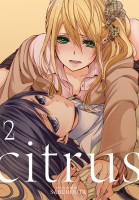 Citrus, Volumes 2-3 by Saburouta. Although I didn’t find some of the first volume of Citrus to be particularly realistic, I did find the intense emotions and drama to be engaging enough to be interested in continuing the series. The next two volumes follow in a similar vein—unbelievable in parts but still having the potential to become addictive. The series has begun to introduce prominent new characters as well. Not only is there another girl who has her eye on Mei, there’s also a young woman with designs for Yuzu. Mei’s father finally makes an appearance in the manga as well, albeit rather briefly. I’m not really entirely sure what to make of the man yet. Mei continues to be something of a mystery, too. One thing is for certain, though, a fair amount of Mei’s emotional issues, which have a huge effect on her interactions with other people, are tied up in her poor relationship with her father. As for the artwork, for the most part Citrus is drawn quite nicely in an overall attractive style that I like, but every so often there’s some weird anatomy going on which can be distracting.
Citrus, Volumes 2-3 by Saburouta. Although I didn’t find some of the first volume of Citrus to be particularly realistic, I did find the intense emotions and drama to be engaging enough to be interested in continuing the series. The next two volumes follow in a similar vein—unbelievable in parts but still having the potential to become addictive. The series has begun to introduce prominent new characters as well. Not only is there another girl who has her eye on Mei, there’s also a young woman with designs for Yuzu. Mei’s father finally makes an appearance in the manga as well, albeit rather briefly. I’m not really entirely sure what to make of the man yet. Mei continues to be something of a mystery, too. One thing is for certain, though, a fair amount of Mei’s emotional issues, which have a huge effect on her interactions with other people, are tied up in her poor relationship with her father. As for the artwork, for the most part Citrus is drawn quite nicely in an overall attractive style that I like, but every so often there’s some weird anatomy going on which can be distracting.
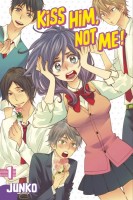 Kiss Him, Not Me!, Volume 1 by Junko. Serinuma is on fairly good terms with many of the hottest boys at her school, but what most people don’t know is that in her spare time she enjoys fantasizing about them in relationships with each other. She’s also a huge fan of the anime Mirage Saga and she’s devastated when her favorite character dies. Locking herself in her room for more than a week, she wastes away. Nearly unrecognizable (on the outside), she begins turning the boys’ heads when she returns to school. Personally, I would have preferred another gimmick than sudden weight loss to bring Serinuma to the attention of her schoolmates, but at least it’s not at all played seriously. In fact, there is very little that is serious about Kiss Him, Not Me!. Its ridiculousness is what makes the manga work. And it is funny. The humor primarily revolves around Serinuma being a hopeless otaku, specifically a fujoshi. Junko herself, who is also a boys’ love mangaka (I believe Mr. Mini Mart is currently her only other work released in English), is a fujoshi as well, so happily the jokes never feel mean-spirited.
Kiss Him, Not Me!, Volume 1 by Junko. Serinuma is on fairly good terms with many of the hottest boys at her school, but what most people don’t know is that in her spare time she enjoys fantasizing about them in relationships with each other. She’s also a huge fan of the anime Mirage Saga and she’s devastated when her favorite character dies. Locking herself in her room for more than a week, she wastes away. Nearly unrecognizable (on the outside), she begins turning the boys’ heads when she returns to school. Personally, I would have preferred another gimmick than sudden weight loss to bring Serinuma to the attention of her schoolmates, but at least it’s not at all played seriously. In fact, there is very little that is serious about Kiss Him, Not Me!. Its ridiculousness is what makes the manga work. And it is funny. The humor primarily revolves around Serinuma being a hopeless otaku, specifically a fujoshi. Junko herself, who is also a boys’ love mangaka (I believe Mr. Mini Mart is currently her only other work released in English), is a fujoshi as well, so happily the jokes never feel mean-spirited.

